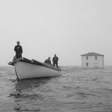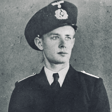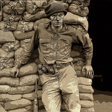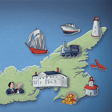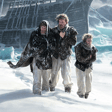Become a Creator today!Start creating today - Share your story with the world!
Start for free
00:00:00
00:00:01

The Distant Early Warning Line
The Distant Early Warning (DEW) Line was a radar defence network in Canada’s Arctic. It was a Cold War engineering marvel, but it had terrible effects on the land and Inuit communities. With Arctic defence once again a topic of concern, Canada's History Society CEO Melony Ward interviews experts about the DEW Line and its impact.
Transcript
Introduction to 'Stories Behind the History'
00:00:00
Speaker
Welcome to Stories Behind the History. I'm Kate Jamit, Senior Editor of Canada's History Magazine, and in this podcast, I interview leading historians and witnesses to history to discover the people, places, and events that shaped our nation.
Melanie Ward's Podcast on DEW Line
00:00:15
Speaker
In this episode, we present a special podcast by Canada's History Society CEO, Melanie Ward, about the distant early warning line, or due line. This radar defense network, built in Canada's Arctic, was a Cold War engineering marvel, but it had a terrible effect on the land and on northern communities.
The Diefenbunker: A Cold War Safehouse
00:00:36
Speaker
Here is our special episode, The Do Line. This is actually very, very cool. Look at it. Hear that? like a geer counter like
00:00:50
Speaker
That's the sound of me and my family walking in an underground tunnel. It's dark. It's freezing cold. The tunnel is lined with corrugated steel. There's light at the end. It's longer than a football field. Such a fallout vibe. It's the entrance to the Diefenbunker, a top-secret underground safe house. It was built by Prime Minister John Diefenbaker in the late 1950s. Top government officials could hop on the train across the street from Parliament, arrive at that same blast tunnel, and live underground. Why did Canada need a safe house for its leaders?
Cold War Tensions and Nuclear Fears
00:01:32
Speaker
three via ana no
00:01:40
Speaker
Ten years earlier, in August 1949, the Soviet Union secretly tested its first atomic bomb. This was the Cold War.
00:01:54
Speaker
I've developed a fascination with the history of technology, especially innovations that have led to the communications technology we have today.
00:02:08
Speaker
During the Second World War and Cold War, governments around the world were chasing a technological advantage. The innovations came fast, and they were enormous. Going to the Diefenbunker and seeing all those old-fashioned radio transmitters, huge oscilloscopes, radio and radar equipment, this may sound weird, but it reminded me of my kitchen growing up. We had those machines scattered around the house, In the late 1950s, my father was a sector superintendent for radar technology in the Arctic. He was in Cape Dyer, Baffin Island, in what is now Nunavut. He managed the biggest station on the distant early warning line, a Cold War radar defense network.
00:02:59
Speaker
Today, we take our wireless tech for granted. Watch cat videos, text friends, hail an Uber, no matter where we are. It's the water we swim in. Wireless technology has its roots in military applications that were all about surveillance. So let's get back to those Cold War roots. It's plainly stated here that the United States is going to the brink of war. All American military forces around the world are on a special alert tonight, including the Strategic Air Command.
USA vs Soviet Union: On the Brink of World War III
00:03:33
Speaker
The U.S. and the Soviet Union never actually declared war on each other. They knew if one side pressed the nuclear button, the other would too.
00:03:43
Speaker
There was an acute tension in the air. It felt like World War III could be tipped off at any moment. And worse, there was a fear it could be triggered by accident, like one Friday morning in November 1979. A computer signal set off alarms at NORAD headquarters. It showed the launch of Soviet missiles. Canada and the U.S. prepped their bombers for a counterattack. A faulty computer signal, which triggered a missile scare at NORAD headquarters in Colorado, has the Soviet Union in an uproar. Today, the Soviet news agency TASS said another computer error could have irreparable consequences for the entire world. Brian Stewart has more. Just before 11 o'clock Friday morning, air defense computers flashed a clear message. Soviet missiles have been launched. Target North America.
00:04:41
Speaker
Two Canadian and eight American interceptors were immediately scrambled, and strategic bombers were about to go when the air was spotted within six minutes. The world had been on the edge of a full-scale nuclear war, and only a handful of people knew it. Well, the air was discovered in a matter of minutes and disaster averted. But there was a real fear that the world could have ended. I remember feeling that nuclear war was inevitable. Ottawa, this is the deal. How are you reading me now? Ottawa, read your five square. Right. There are some breaks in the due line. The commander is just checking. Commander in chief, sir, this is the commander of Northern. I've been advised by my intelligence section that there are some breaks in the distant early war line. in the eastern portion near Greenland. That's from a film NORAD made about what nuclear doomsday would look like from the control center. The military commander is so calm, by defense analytical. A strength of 12 unknown objects assumed to be hostile. Meanwhile, Dio, I understand that we have received the nuclear authority
00:06:04
Speaker
from the Canadian government. good check out the authentication go up we got ours
00:06:17
Speaker
looks like we're in business The two sides of the Cold War had an unspoken agreement. Not to trivialize, but it makes me think of two kids. You don't knock my sandcastle down and I won't knock yours down. Except with bombs. The world would stay safe and secure because of the nuclear arsenal. No side would act first because they knew the other side would respond with a bomb. The price of peace in this atomic era is strength and constant readiness to defend ourselves and our homes from any aggression. A single blow can today destroy the mightiest nation if the blow is allowed to fall.
00:07:01
Speaker
The fact of mutually assured destruction was a kind of insurance against aggression.
Building the DEW Line in the Arctic
00:07:06
Speaker
This is where the distant early warning line, or due line, came into play. The nation's leaders decided on a tremendous undertaking. This was to build a radar early warning line north of the Arctic Circle. Starting at the northernmost tip of Alaska, It would stretch 3,000 miles across the continent to Baffin Island, opposite Greenland. Distant early warning line, they named it. Due line, it became.
00:07:40
Speaker
The due line was built during a peak period of Cold War tension starting in the mid-1950s, a continental defense system, a string of radar stations that span North America and later Greenland and Iceland. The shortest route for a nuclear missile from the USSR to reach cities in the United States was to take a path right over the North Pole, a path that required using Canadian airspace. What was once the impassable Arctic now provides the quickest routes for attack from a wide sector of Europe and Asia.
00:08:24
Speaker
If the Soviet Union launched atomic weapons using that shortcut, the due radar technicians would alert North American Aerospace Defense Command. That would give the US Air Force three to six hours warning to take defensive action. So, if the Arctic was so impossible, how did these huge distant early warning stations get built? at the proposal to create such a line in that distant wilderness old arctic hands shook their heads in doubt
00:08:55
Speaker
but the de line had to be built there An unknown frozen wasteland? and transform it into a vital outpost of western civilization
00:09:07
Speaker
and unknown frozen wasteland The contractors for the US Department of Defense consider the Arctic empty and an unthinkable place to live. But that southern view of the Arctic, it was false. Families have lived, worked, traveled, and prepared meals in the Arctic since time immemorial. I wanted to better understand due line stations and their effects in the Arctic during the Cold War. The dew was the largest and most remote construction project in North America at the time.
Impact on Indigenous Communities
00:09:43
Speaker
Absolutely everything had to be brought from the south by sea or air. Every stick of wood, nails, tools, fuel, snow plows, technical equipment, tractors were even dropped by parachute.
00:09:59
Speaker
Design and construction were happening at the same time. They had two short arctic summers to get it done. How did this mega project get built so quickly? What were its effects on the people who work there and who have always lived there? I spoke with Matt Farish. He's an associate professor at the University of Toronto and collaborator on the book, The Coldest War, a history of the distant early warning line I asked him, who built the due line? this is one of the most compelling and complicated aspects of the story i think is the actual design development construction of the line
00:10:38
Speaker
the simplest way to understand it is that it was a project of the united states air force in close relationship with Canadian government partners that is then contracted out through a series of contracts and subcontracts down the line, so to speak. The key industrial or corporate actor is the Western Electric Company, which is the engineering arm of the the massive bell system that we're all still familiar with.
00:11:10
Speaker
And so Western Electric then goes out and subcontracts and arranges for a dizzying number of contracts of smaller firms, construction companies, transportation companies um to get the materials up to the high Arctic and then actually have this built. So what did these do-line stations look like? Have you seen pictures of Buckminster Fuller's geodesic dome from Expo 67 or a Cinesphere at Ontario Place? They're geodesic domes. The dew stations had those domes too, before they became symbols of utopia. They looked like weird giant golf balls. Alien space stations just plopped on the land. They housed the radar equipment and kept it safe from the elements.
00:12:01
Speaker
they would often look like a cluster of low slung seemingly temporary or prefabricated buildings. Some people refer to them as submarines. They look like trailers, essentially. They're very sit simple in design, um and they would be clustered up um some distance from, not very far from a kind of major radar facility, complete with the famous radome or golf ball that we associate with military radar.
00:12:36
Speaker
The harsh climate and terrain required hundreds of people to move quickly. Matt said hundreds more were needed once the stations were up and running. They would be employees of the contractor who would come up for stints, six months or a year at a time often, to work on the line across a small number of employment categories from radar technicians to um engineers to the folks who actually maintained the property. It was a very small number at some of the secondary and tertiary stations, maybe four or five people sometimes. But then at these major stations, there would be more of a support staff. There would be laborers. This is where we see the role of indigenous labor as well, particularly young, Inuit men working at certain stations. And while the region was seen as uncharted territory by the military, there were, of course, long-standing communities in the Arctic.
00:13:33
Speaker
How did the dew affect indigenous lives, economies, and culture? Who's included in the dewline narrative? There are interesting repercussions as people move off the land and into some of these new communities or communities that now have dewline stations. There are complicated ripple effects across families as men leave seasonal ah work to move on to a due line station for work and their partners and kids are not permitted on the station. You might call it a military modernization piece as a bringer of
00:14:09
Speaker
a certain kind of technology but also I think more importantly a certain kind of normalized southern lifestyle carried by these southern employees who are coming up north and consuming certain kinds of food and living on these stations and watching movies and so on that come into a relationship, a complicated series of relationship with indigenous lives in the north. Inuit peoples helped build and operate the dew stations, but their families, ways of life, and economies were terribly disrupted. Didn't anyone think about this when the dew was being planned?
00:14:47
Speaker
There is virtually no reference to northern people on the part of the U.S. military or the U.S. scientists who are thinking about the due line. But in Canada, the story is a little bit different, particularly because the the federal government is grappling with complicated understandings of, quote unquote, responsibility for indigenous peoples in the north. and elsewhere and so the due line enters into this stew of debates and discussions, many of them quite paternalistic but some of them more thoughtful. Once it was decided that this needed to be done and that it should be done,
00:15:27
Speaker
forget the cost, forget the effects on the land and the lives of people, it needs to be built. And the sort of sheer combination of hubris and confidence and determination and a sort of shortsightedness as well about putting this in place. um And it's not at all to excuse any of it, but ah that That determination overrode every other possible calculation of of consequence.
00:15:59
Speaker
Matt also told me about a sociologist from the late 1950s named J.D. Ferguson. The Canadian government sent him north along with a group of students to research the impact of the dew on northern communities, communities that were primarily indigenous. You know, he understands the dew line as being a significant piece of a huge change that is sweeping the north. and really pointing out to his superiors and other people who are reading his reports back in Ottawa that as much as you might like to talk about trying to limit the consequences of something like the due line on Northerners, it's impossible.
00:16:40
Speaker
So it's not just in hindsight that we recognize the damage the duke caused to indigenous peoples. There was a recognition as early as the 1950s. My recollection is that he felt that his work was effectively shelved. Given that kind of Cold War, national security, imperative that seemed to overwhelm other kinds of concerns about civil rights or about, you know, understanding the the the ripple effects in terms of economic and social life in northern communities.
Lasting Effects on Arctic Land and Peoples
00:17:12
Speaker
And so this was a project that in that Cold War logic of national security had to be built, of continental defence had to be built, and dam the consequences, frankly, at the end of the day.
00:17:24
Speaker
The consequences were substantial on lives, but also on the land. In the last um couple of decades, there has been an enormous attempt to clean up Northern radar facilities at a cost of something like $500 million dollars of our money. um And so the kind of uncanny echoes of this coming back in the latest um versions of Northern militarization, you have um In particular, contractors owned by or employing significant numbers of indigenous people to clean up the waste of the due line and other activity that was put down there in the 1950s. In 1998, a year before the creation of Nunavut, CBC North reporter Timothy Sawell looked at the toxic legacy of the due line in Tuktaiaktuk. All the building waste that was supposed to be buried is now being stored on site.
00:18:21
Speaker
Hundreds of huge orange metal transport containers lie in the area filled with the waste. Signs on the containers warn community residents. Danger, PCBs. An international study now shows that people in the Arctic are exposed to some of the highest levels of chemical contamination in the world. It found that Inuit children are at risk. To understand the impact of military radar on a community, I talked to Barry Anderson, who lives in McCovick, Newfoundland, and Labrador. His community is next to a small radar station. My name is Barry Anderson and I'm from McCovick, Newfoundland, and Labrador.
00:19:00
Speaker
it's a newly yeah develop land clean area yeah in order la
00:19:08
Speaker
are In his youth, he had lots of experience with the radar station down the road from his town. I'm born and raised here in Macombic. My dad and some of my uncles are also from here and worked and fished here all their lives and would tell stories yeah about the due line site. I'm also a Canadian ranger with Department of National Defence. So I'm a National Corporal in that organization. We do maintenance checks on the radar sites that's automated here on the north coast of Labrador now. We do that biannually twice a year. yeah Just to ensure that the but domes and everything is in place. There's no rips or tears and things like that. Any damage, ah wind damage or things like that to the sites. We report back to North Bay, Ontario. and through our headquarters in gand
00:20:07
Speaker
There's still a military surveillance presence in the north, the North Warning System. Barry is part of that as a Canadian ranger, part of the Canadian Armed Forces Reserve. He monitors the former GAP radar site and has seen the environmental consequences. There's still there, you see up a whole bunch of little derricks that spoke to see what was discarded. by the americans just into the sand the and reader played at hopefield that went the next community north of here
00:20:39
Speaker
It had a major impact on the community there, for sure, as it was right in town. And right to this day, they can't be built in certain areas because of the tar and PCBs that's discarded there. And it's too difficult to clean up, I guess. it's People thought that it was, or the young people would think it's bedrock, but it's just solid oil on the rock and ground up there. and that community still dealing with it yeah there's a high incidence of cancer and stuff in the area so
00:21:11
Speaker
probably are from the scene discarded pcbs and that kind of thing two countries working together to provide their own long-range defense, an unparalleled example of harmonious cooperation between sovereign nations.
00:21:31
Speaker
Was everything and everyone really working together so harmoniously? I don't think so. The do-line cleanup was declared complete in 2014, but the environmental and community effects are still felt.
The Myth vs Reality of the North
00:21:48
Speaker
There's such myth-making around the idea of the North. Snow-laden, empty, untouched. That's the idea of the North, but it's not the lived history. It's not the history of Barry Anderson and his community. And it's not the present of many communities that developed around or had contact with military radar installations. I went to visit someone else who spent a lot of time in the North. This time, a former due line worker from the South, Brian Jeffrey,
00:22:24
Speaker
I'm just driving along Donald B. Monroe Drive out in the middle of a beautiful white snow field past Farmland Road and then all of a sudden there are these geodesic domes and they're just there on their own. So I'm pulling over to just see what this is. And CSS, Canadian Space Services Limited. So apparently these geodesic domes still have a function. Atheon. I'm going to get out of the car and see what's going on.
00:23:05
Speaker
Fortunately, they plowed. This area is under 24-hour video surveillance. I don't know, I might not be allowed in here.
00:23:16
Speaker
After traipsing through a restricted area, I figured I'd better get out quickly. I drove another 10 minutes down the road to the home of Brian Jeffery, just near the defunct bunker in Carpontario. He worked as a radar technician, or a radition, on the due line in the early 1960s. We settled into his basement radio room, filled with memorabilia from the due line. This is my, yeah I guess the term is man cave, what I don't think is a particular term. It's a nice man cave. It's a nicer man cave than I've ever seen. It's a ham shack.
00:23:53
Speaker
I wondered, how does someone end up working at a radar base in the Arctic? So i get I got sucked into going up there by my mother who wanted to get rid of me and she found an a nad in the paper. But I was working at the National Research Council at the time. looking after a computer there, which was, turns out, by now- Very early computer. We're talking 1957. This was the very first computer ever sold in Canada. So what did you do on on the due line? I was at what was called a radition, which is radar technician.
00:24:29
Speaker
yeah And so, yeah, as a rendition, you spent four hours of your shift watching the radar and another four hours doing maintenance and usually preventive maintenance is really some of the things great. Main station, as I said, around 50 maybe, 75 on a really bad busy day. Ox sites were normally 15 people, 14 to 15, over seven of us were technicians. And there may be a couple more and in the summertime when you got work on. The eyesight, I think the one I was at, we were five of us, and that was it. And I was there for six months.
00:25:04
Speaker
But that was my doorway into the sector crew, which was the the elite of the elite technicians. And I said, i wanted that's where I wanted to be. And they said, well, you go to an eyesight for six months, and we will nobody wanted to go to an eyesight. Absolutely nobody. it was You're the only technician there. You cannot leave the building, theoretically, because you have to be there instantly when the alarms go off to to change whatever needs to be done. You can imagine that some of the communications were highly secret and could only be reviewed by military officials with proper clearance. Each main station would have about five or six military personnel. The Canadian ones were primarily Canadian with a U.S. officer. The ones in the U.S. were primarily U.S. officers by the Canadian contingent.
00:25:52
Speaker
So there was always both at those sites. There were certain messages that came into the stations that they would hand to the military personnel because they had higher security clearance. They probably would have been encrypted. yeah And so at each station, there was at least one, if not two, crypto technicians. They were always American. So the Canadians were never allowed to to encrypt or decrypt messages. We were simply weren't trained. and the message itd be it It'd be a Twix, basically. A Twix is basically the Morse code message. That we couldn't understand. There's just gibberish until you feed it through the crypto machine. and know It's like the, yeah what's the German one, the Enigma. You type in things and the message comes up. Oh, did it actually look like that? No. In fact, I've never seen one. I've seen pictures of them, but we were not allowed
00:26:42
Speaker
back in that area. But during the Cuban Missile Crisis, what we did is we doubled up on the radar and there was tourists there and we stopped doing any maintenance unless something broke. And we were not sure there was going to be a South to come home to. And we also knew that nobody was going to come and get us. 15 people in the middle of nowhere, you know, ain't going to happen. No South to come home to. The isolation of the due line and anxiety about the state of the world changed him for the rest of his life.
00:27:15
Speaker
A lot of people don't understand how such a small part of life, I mean, I'm 79 now, that was three years out of 79. Why does it live so big? Why is it such an enormous event? And I think it's because it was such a unique experience shared by so few people. and There's a brotherhood, unspoken brotherhood, and somebody somebody once said, once a do-liner, always a do-liner.
00:27:49
Speaker
So many players, so many lives affected, some for a few months and some for generations. The Cold War's sense of duty that doing what needed to be done, it can't be detangled from the intrusion into ways of life. It affected individuals, communities and nations. And its reality in the Arctic means we can't think of the North as an idea It's a land with history and people.
Legacy of Cold War Military Advancements
00:28:22
Speaker
Decades on from the end of the Cold War, I can't help but marvel that there's probably as much communication power right now in the palm of my hand than there was at Cape Dyer or the Diefenbunker.
00:28:37
Speaker
That power, so much a part of our contemporary life, owes so much to the militarization of technology, the militarization of the Arctic, as well as their terrible consequences.
00:29:05
Speaker
This program was produced by me, Melanie Ward, with assistance from Sarah Martin. Special thanks to Nancy Payne and Kylie Nicholson. Our sound editor is Andrew Workman. Thank you to CBC Licensing and the AT and&T Archives and History Center.
00:29:27
Speaker
The Stories Behind the History podcast is produced by Canada's History Society. If you enjoyed this episode, please subscribe to the podcast and leave us a rating or a review. It helps other listeners to find us. If you'd like to read more stories about Canadian history, why not subscribe to Canada's History magazine? Our beautifully illustrated glossy magazine will be delivered to your home six times a year, chock full of interesting stories written by Canada's top historians and journalists. To subscribe to the magazine, go to canadahshistory.ca slash subscribe. Our theme music is the Red River Jig performed by Alex Kustarok from his album May T Fiddling for Dancing. I'm Kate Jamit. Thanks for joining me.


